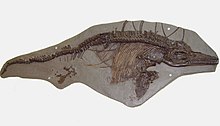Parvipelvia
| Parvipelvia | |
|---|---|

| |
| Ichthyosaurus brevicepsfossil | |
| Scientific classification | |
| Domain: | Eukaryota |
| Kingdom: | Animalia |
| Phylum: | Chordata |
| Class: | Reptilia |
| Order: | †Ichthyosauria |
| Clade: | †Euichthyosauria |
| Node: | †Parvipelvia Motani,1999 |
| Subgroups | |
| |
Parvipelvia(Latinfor "little pelvis" -parvusmeaning "little" andpelvismeaning "pelvis" ) is anextinctcladeofeuichthyosaurichthyosaursthat existed from theLate Triassicto the earlyLate Cretaceous(middleNoriantoCenomanian) ofAsia,Australia,Europe,North AmericaandSouth America.Named by Ryosuke Motani, in 1999, it contains the basal taxa likeMacgowaniaandHudsonelpidia.[1]Maisch and Matzke (2000) found in their analysis seven synapomorphies that support Parvipelvia. They also found 10 synapomorphies that support the existence of post-Triassic clade of ichthyosaurs (all parvipelvians excludingMacgowaniaandHudsonelpidia), for which the name Neoichthyosauria was found to be available.[2]Parvipelvians were the only ichthyosaurs to survive theTriassic-Jurassic extinction event.
Phylogeny
[edit]Parvipelvia is anode-based taxondefined in 1999 as "the last common ancestor ofHudsonelpidia,Macgowania,Ichthyosaurusand all of its descendants ".[1]Maisch and Matzke (2000) also defined Neoichthyosauria which is a node-based taxon originally named by P. Martin Sander in 2000, as "the last common ancestor ofTemnodontosaurus trigonodonandOphthalmosaurus icenicusand all of its descendants ".[2]Thecladogramsbelow follows Motani (1999) and Maisch and Matzke (2000).[1][2]
| Parvipelvia |
| ||||||||||||||||||
| Parvipelvia |
| |||||||||
References
[edit]- ^abcMotani, Ryosuke (1999)."Phylogeny of the Ichthyopterygia"(PDF).Journal of Vertebrate Paleontology.19(3): 472–495.Bibcode:1999JVPal..19..473M.doi:10.1080/02724634.1999.10011160.Archived fromthe original(PDF)on 2016-03-05.Retrieved2011-10-19.
- ^abcMaisch, Michael W. & Andreas T. Matzke (2000)."The Ichthyosauria"(PDF).Stuttgarter Beiträge zur Naturkunde.Serie B (Geologie und Paläontologie).298:1–159. Archived fromthe original(PDF)on 2014-11-05.Retrieved2018-03-20.








